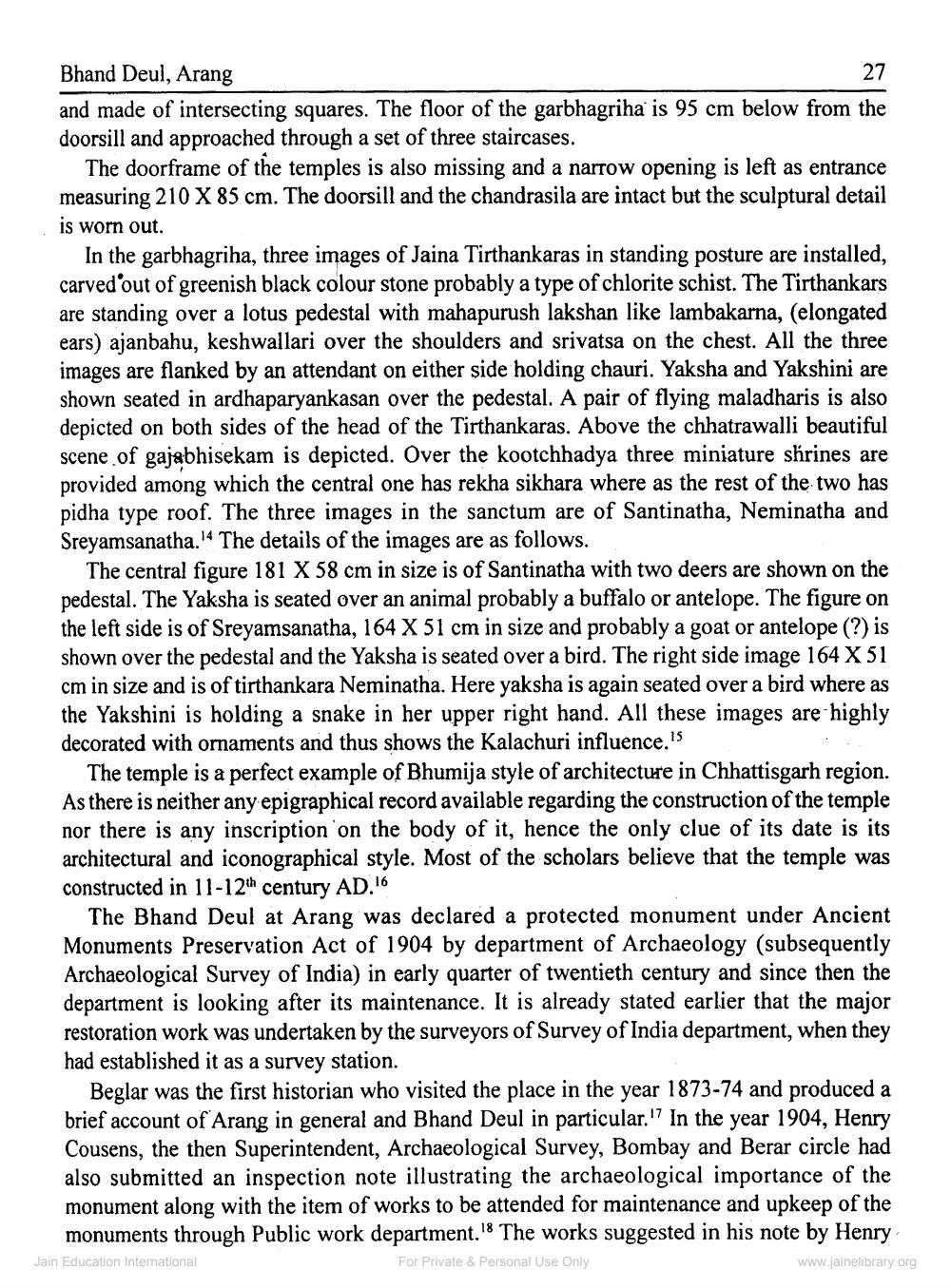________________
Bhand Deul, Arang and made of intersecting squares. The floor of the garbhagriha is 95 cm below from the doorsill and approached through a set of three staircases.
The doorframe of the temples is also missing and a narrow opening is left as entrance measuring 210 X 85 cm. The doorsill and the chandrasila are intact but the sculptural detail is worn out.
In the garbhagriha, three images of Jaina Tirthankaras in standing posture are installed, carved out of greenish black colour stone probably a type of chlorite schist. The Tirthankars are standing over a lotus pedestal with mahapurush lakshan like lambakarna, (elongated ears) ajanbahu, keshwallari over the shoulders and srivatsa on the chest. All the three images are flanked by an attendant on either side holding chauri. Yaksha and Yakshini are shown seated in ardhaparyankasan over the pedestal. A pair of flying maladharis is also depicted on both sides of the head of the Tirthankaras. Above the chhatrawalli beautiful scene of gajabhisekam is depicted. Over the kootchhadya three miniature shrines are provided among which the central one has rekha sikhara where as the rest of the two has pidha type roof. The three images in the sanctum are of Santinatha, Neminatha and Sreyamsanatha.! The details of the images are as follows.
The central figure 181 X 58 cm in size is of Santinatha with two deers are shown on the pedestal. The Yaksha is seated over an animal probably a buffalo or antelope. The figure on the left side is of Sreyamsanatha, 164 X 51 cm in size and probably a goat or antelope (?) is shown over the pedestal and the Yaksha is seated over a bird. The right side image 164 X 51 cm in size and is of tirthankara Neminatha. Here yaksha is again seated over a bird where as the Yakshini is holding a snake in her upper right hand. All these images are highly decorated with ornaments and thus shows the Kalachuri influence.rs
The temple is a perfect example of Bhumija style of architecture in Chhattisgarh region. As there is neither any epigraphical record available regarding the construction of the temple nor there is any inscription on the body of it, hence the only clue of its date is its architectural and iconographical style. Most of the scholars believe that the temple was constructed in 11-12th century AD.16
The Bhand Deul at Arang was declared a protected monument under Ancient Monuments Preservation Act of 1904 by department of Archaeology (subsequently Archaeological Survey of India) in early quarter of twentieth century and since then the department is looking after its maintenance. It is already stated earlier that the major restoration work was undertaken by the surveyors of Survey of India department, when they had established it as a survey station.
Beglar was the first historian who visited the place in the year 1873-74 and produced a brief account of Arang in general and Bhand Deul in particular." In the year 1904, Henry Cousens, the then Superintendent, Archaeological Survey, Bombay and Berar circle had also submitted an inspection note illustrating the archaeological importance of the monument along with the item of works to be attended for maintenance and upkeep of the
monuments through Public work department. 18 The works suggested in his note by Henry Jain Education International For Private & Personal Use Only
www.jainelibrary.org




